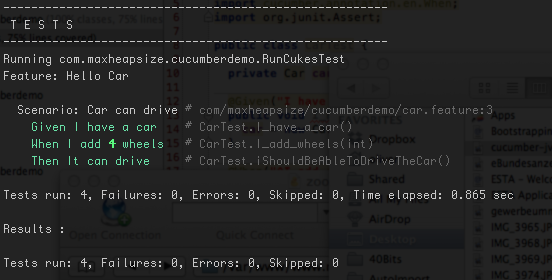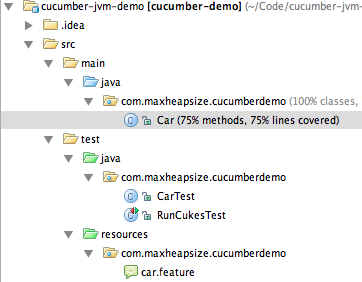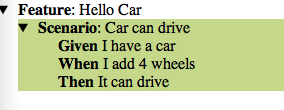Cucumber-jvm for Java
In an earlier article I compared cucumber (with Cuke4Duke) and Concordion. It was very cumbersome due to the ruby/jruby jvm chain. Behold - the new cucumber-jvm was released. So how did it improve ?
Cucumber-jvm has support for many languages, e.g. Scala, Groovy, Closure and of course Java. I will focus on Java and Maven.
To get you maven project going you just need to include the following dependencies:
{% include_code [Dependencies] cucumber-jvm/pom.xml %}
First thing you (or your Business Analyst or something) is doing, is describing your feature. It would look something like:
Feature: Hello Car
Scenario: Car can drive
Given I have a car
When I add 4 wheels
Then It can drive
You need to put that into a file called Car.feature. The .feature extension is important.
To get all Cucumber-jvm tests off the ground we need one test runner. I often see it being called RunCukesTest.
{% include_code [Test Runner] cucumber-jvm/RunCukesTest.java %}
You note the Cucumber.Options annotation. It will also produce a nice html in the given directory.
Writing the test now itself is no different than with Cuke4Duke.
{% include_code [The test class] cucumber-jvm/CarTest.java %}
You need to match the .feature description with @Given, @When, @Then**** Annotation (regexp that is). Each usage of any of the annotations is called a step definition. Each one must be unique among all .feature files (as far as I can tell). The code will be executed accordingly.
A maven test will get you:
 Make sure you put your .feature file in the **right location**. It needs right next to tests. I tend to put it into the resources folder in maven so it does not 'pollute' my Java source files.
Make sure you put your .feature file in the **right location**. It needs right next to tests. I tend to put it into the resources folder in maven so it does not 'pollute' my Java source files.
 Finally your Html report is rendered (somewhat nicely and collapsable).
Finally your Html report is rendered (somewhat nicely and collapsable).
 And yes, this applies to cucumber-jvm version 1.0.2.
And yes, this applies to cucumber-jvm version 1.0.2.
I hope you found that useful as very short intro into cucumber-jvm. If you are wondering if you would want to use concordion check out my older blog post.
If I would have a choice again.I would choose cucumber-jvm for using a BDD tool. The plain text format makes it easy to read for a non programmer and it produces somewhat good documentation (if used well of course ;-) ). The tool chain is much smoother now and faster as well.
What I found missing is support for my favorite unit test tool TestNG. I also don’t know yet how to execute a single feature/scenario when having multiple ones (which will be almost certain always the case).
The learn more about cucumber checkout their website.
The code used above is available on GitHub
